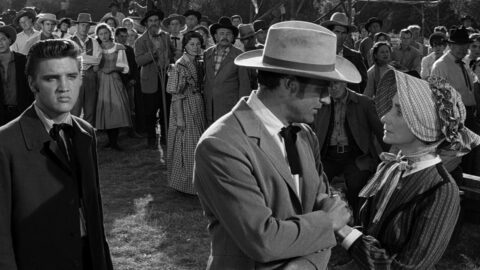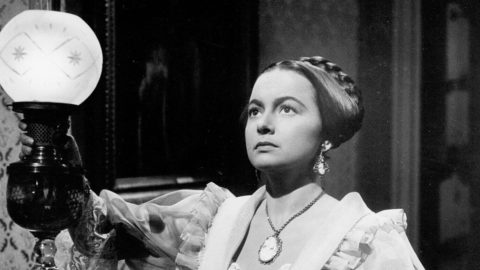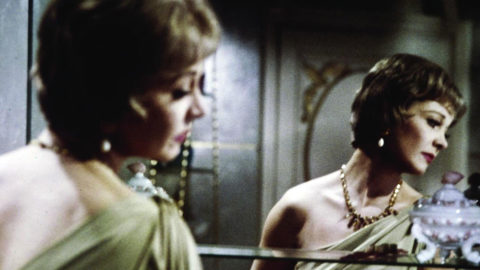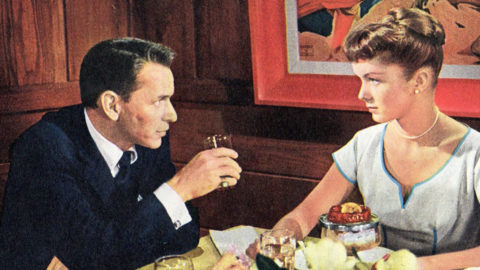TCM Diary: Phil Karlson Represents

There are many reasons that it’s worth paying attention to politics, but perhaps the most important of these is that what goes on in the political sphere has the potential to kill or cause grievous physical harm to you, the people you know, or people who you don’t know who nevertheless deserve better.
This fact is something grasped intuitively and communicated on a gut level by The Phenix City Story, a movie with a real-life ripped-from-the-headlines premise made by genre utility man Phil Karlson and released in 1955 by Allied Artists Pictures—the gussied-up rebrand of Poverty Row mainstay Monogram Pictures. Karlson had cut his teeth at Monogram when he was making his way up through B-pictures, but by ’55 he’d broken through to bigger things, distinguishing himself as a specialist in screen brutality boasting a rich repertory of gutterfighting techniques including rabbit punches, windpipe chops, and cupped hand ear strikes. Karlson got right into the scrum when shooting fight scenes like the slugfest boxing match full of up-the-nose angles that opens his 99 River Street (1953), and long before it was the norm he was cutting ragged bits of handheld work into his donnybrooks, like the close-quarters brawl between John Payne, Lee Van Cleef, and Neville Brand in Kansas City Confidential (1952). Even his Elvis movie goes pretty hard—Kid Galahad (1962) is definitely the only film with a Col. Tom Parker credit in which Charles Bronson has both of his hands broken by mobsters.
Like his rough contemporary Andre de Toth, Karlson put a premium on realism—“Every successful picture I’ve made has been based on fact,” he told Todd McCarthy in a 1973 interview. “Sure, plenty of fiction enters into it, but the basic idea is true.” The basis of The Phenix City Story was the murder of Albert Patterson, killed by an unidentified assailant who delivered three point-blank shots to him on the evening of June 18, 1954, eight days after it was announced that Patterson had secured the Alabama Democratic Party’s nomination to run for Attorney General of the state, and just a little over a year before the release of the movie. Patterson had run for Attorney General on a promise to sweep the vice industry out of his hometown of Phenix City, which indeed would be cleaned up following his death by a National Guard detachment led by Gen. “Crack” Hanna. Separated by the Chattahoochee River and the state line from Columbus, Georgia, Phenix City for years served its significantly more populous neighbor in the role of “sin city,” the designation given to urban areas that play Hyde to an upstanding and better-known Jekyll locale, whose upstanding community pillars need somewhere to go to booze and carouse and roll dice without having to worry about being seen by the pastor—Steubenville, Ohio, birthplace of Dean Martin, played the part for Pittsburgh; Newport, Kentucky to Cincinnati; Mooresville, North Carolina to Charlotte; and on and on.
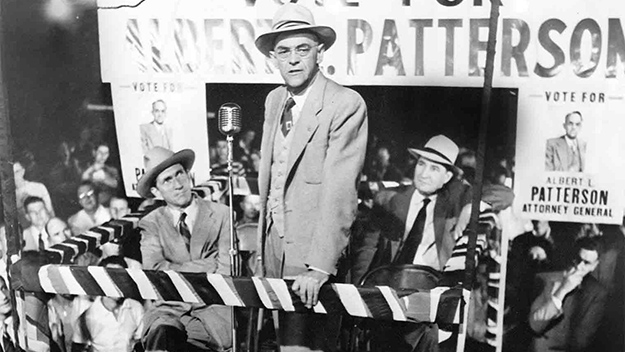
The events surrounding Patterson’s death, and the ins and outs of Phenix City’s lucrative vice industry, operated by a good ol’ boy “syndicate” in collusion with corrupt local government, are explained in The Phenix City Story’s documentary overture, which has Los Angeles–based news anchor Clete Roberts interviewing various locals—a reporter from the Birmingham News; anti-machine campaigners including a survivor of a syndicate assassination attempt; the courthouse janitor, a witness in the case, now deputized and packing heat; and Patterson’s widow—whose untutored replies and twangy diction are enough to convince that they are not professionals. Such newsreel-style preambles weren’t unknown; you can see instances in Anthony Mann’s T-Men (1947) and He Walked by Night (1948), for example. The extensiveness of its use in The Phenix City Story is unusual however and, to my knowledge, even unprecedented, taking up a full 13 minutes of screen time, more if you count the post-opening credits documentary footage narrated by Richard Kiley in the character of John Patterson, son of the deceased Albert.
When the fiction segment of The Phenix City Story begins, we are in business-as-usual Phenix City, the heart of it identified by Kiley as rowdy 14th St., home of a $100 million-a-year vice industry dependent on bootleg liquor and shaved and loaded dice. The rigged slot machines are ringing, the raw recruits are pouring in from nearby Fort Benning to sit with hard-faced gals and listen to a combo bang out the “Phenix City Blues” at The Poppy Club, and anyone who has the temerity to say something about the cards being marked risks winding up in the river. We are introduced to 14th St. overboss Rhett Tanner, played with a purring delivery and easy, louche limpness by Edward Andrews, seen bickering with his peroxided gal pal (Jean Carson) then, en route to Patterson’s office, glad-handing his way through city streets that he walks with a proprietary air, all shot on location. Karlson’s attention to correct detail on all points is felt, though not dwelt on. One of the locals who Rhett greets on the street is Beachie Howard aka “Ma” Beachie, the proprietress of Phenix City hoochie-coochie joint Beachie’s Swing Club, and John McIntire, playing Patterson, reportedly took his character wardrobe from the deceased Patterson’s closet.
When first introduced, McIntire’s Al “Pat” Patterson is no crusader but a middle-aged man somewhat grousily accustomed to the state of affairs in town, riding the fence between machine interests and the increasingly noisy reform elements in the city who have bonded together as the Russell County Betterment Association. The uneasy truce is disturbed when Patterson’s son, fresh out of the military, arrives home on a flight from Germany with his wife and two children, ready to take a part in the family business. Al takes pains to reassure his son’s spouse, Mary Jo (Lenka Peterson), that Phenix City is as good a place as any to raise a family, but on the first night back John gets mixed up in a lopsided parking lot brawl while the beat cops stand by watching, and comes home bloodied and battered, determined to roll up his sleeves and clean out the Augean Stables of 14th St.
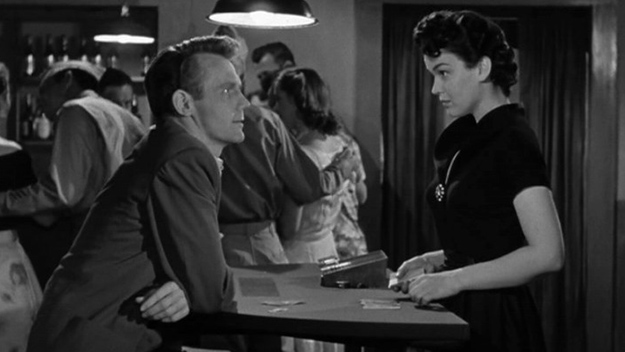
Karlson’s crew came into Phenix City while the Patterson trial was still underway in Birmingham, and though there is undoubtedly a bit of ballyhoo in the stories of the production being menaced by syndicate interests, the movie still has a palpable sense of boots-on-the-ground danger about it. The director was not the type to be intimidated. Asked by McCarthy about his cycle of 1950s “crime melodramas,” Karlson responded: “I was born in Chicago, and I was raised in Chicago, and I went through the days of the killings and whatnot in Chicago. I remember getting 25 cents to stand on a corner, and if the cop was on this side of the street, to whistle real loud, and if he was on that side of the street, just to whistle softly. I was keeping a brewery going by a little whistle . . . When I got a little older, in high school, I actually came out of a theatre, and the man in front of me was gunned down—a car pulled up alongside and gunned him down. They put five bullets in this man and he lived. His name was David Miller and he had a restaurant on the West Side of Chicago, and his brother was a lieutenant of detectives on the police force. The result of this, and I was old enough now to understand what was going on, was the killing of a great mobster by the name of Dion O’Banion.”
Karlson, who died in 1982, was by his own confession not much of a publicity hound. He didn’t leave behind many such extensive interviews to serve at burnishing his legacy, and is remembered today mostly for turning out tough, efficient work—a sort of lesser Don Siegel, perhaps. In fact the parallels between the two men’s careers are numerous. Both were Chicagoans, both had Jewish ancestry, and both broke into the picture business in the 1940s, working for time as cutters, an experience which would distinguish the later work. They were each responsible for a strong Elvis picture (Siegel with 1960’s Flaming Star); and each made their biggest films late in their careers, in 1970s works concerned, in their individual ways, with the question of vigilante law: Siegel’s Dirty Harry (1971) and Karlson’s Walking Tall (1973), the latter a near-remake of The Phenix City Story, though here the slain real-life protagonist is Sheriff Buford Pusser, played by Joe Don Baker, doing war with the State Line Mob in McNairy County, Tennessee at the end of his home-whittled whuppin’ stick.
One essential difference between the men, however, is indicated by McCarthy’s use of the phrase “crime melodramas” to describe Karlson’s ’50s output—particularly the “melodrama” part. While some kind of a romantic subplot, often perfunctorily treated, was generally expected in even the most macho of genre product, Karlson’s work is distinguished by the attention that he gives to male-female relationships. Because of this, the pull towards violent action in Karlson’s films is counterweighted by present or potential domestic happiness, as the women struggle to dissuade their men from a course of potential destruction or diffuse building tension. In Karlson’s filmography, frenzy and hysteria are decidedly masculine traits. In Walking Tall it’s Elizabeth Hartman, playing Pusser’s wife, Pauline, who tries to restrain him from the fray. Nightclub chanteuse Kim Novak is the voice of reason against a claque of college boys planning a casino heist in 5 Against the House (1955); The Brothers Rico (1957) finds Floridian ex-mob accountant Richard Conte trying to square his syndicate debts so he can adopt a kid with wife Dianne Foster; and in Kid Galahad Joan Blackman wants to get Elvis out of the ring before he gets his ears cauliflowered and brains scrambled. (1955’s VistaVision Technicolor noir Hell’s Island is in this company a bit of an outlier, featuring Mary Murphy in fine femme fatale fettle.)
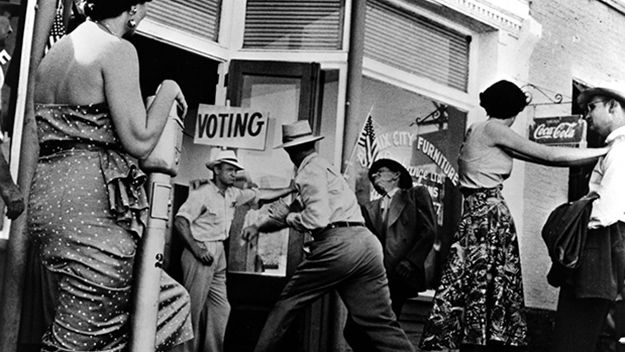
Both Kansas City Confidential and The Phenix City Story contain a strikingly similar scene in which the female lead—Coleen Gray in the former film, Peterson in the latter—is taken aback by the sight of a revolver that her love interest has left laying casually about. If the spectacle of violence in Karlson’s films seems, still today, especially impactful, it is in part because he gives this attention to the female perspective, in particular the horror that women feel when bearing witness to male violence. As a result, there may be an abundance of violence in a Karlson movie, but it never comes to seem normal.
Women aren’t only witnesses to violence in Karlson’s films; they are also not-infrequently its victims—this is ugly, and also true-to-life. (On re-watching a line from “Phenix City Blues” stood out, intended as seductive in the context of strip-tease performance but ominous given the content of the film: “Woman’s body is made of flesh and bone”) Walking Tall depicts Pauline becoming collateral damage in the State Line Mob’s struggle with her husband, and is possessed of one of the more troubling endings in 70s American movies, in which Pusser last appears wearing a mask of white plaster, seeming now less a man than a solemn southern golem.
In The Phenix City Story, the most shocking act of violence of the very many that we see is one committed against a child—the daughter of Zeke Ward (the always excellent James Edwards), an African-American man of about John’s age who sweeps up at The Poppy Club, and who gets involved in a dust-up there on the side of John and a local reform rabble-rouser, Fred Gage (Biff McGuire). A car rolls up alongside the girl as she’s skipping across a bridge and a syndicate goon steps out. The camera, placed at the level of the child’s eyeline, swivel pans from her split-second reaction to look up at the looming menace before her. She screams, a brief struggle ensues, and the next thing we know the same car is dropping a small, bound black body next to the Patterson home, where the kids are in the yard, the youngest in a crib. The body is stiff and perhaps too evidently a dummy, but for whatever reason this doesn’t detract at all from the horror of the scene—if anything it seems to underline the fact that a very-recently-living little girl has now become a broken thing. The syndicate car peels off, shellacking a boy passing on his newspaper route as it does, and after the Patterson children, hysterical, shrieking, and traumatized for life, have been huddled inside, we get a glimpse of the response at the Phenix City police department. “Somebody’s just threw a dead nigger kid out on Patterson’s lawn,” says the dewlapped dispatcher, between bites of a sandwich.
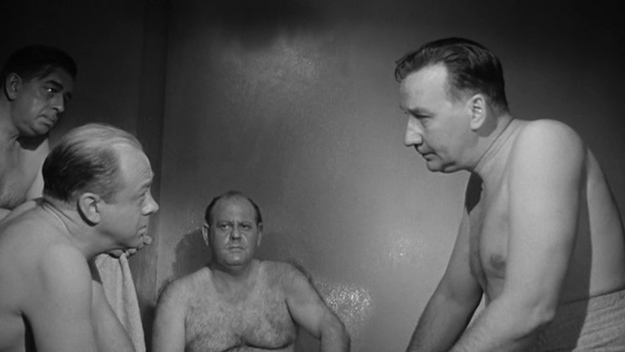
The subject matter of The Phenix City Story isn’t the African-American civil rights movement, then in its early stages, but it is difficult to imagine that any tuned-in viewer could fail to draw some connection to the news of the day when watching these scenes, or reading the opening text that states: “A people united in the common cause of decency could peaceably overthrow the yoke of oppression under which they had existed for almost one hundred years.” About a month previous to the murder of Patterson, the Warren Court’s decision on Brown v. Board of Education was handed down, and little over a month after The Phenix City Story had an unusual triple premiere in Phenix City, Columbus, and Chicago, Chicagoan Emmett Till’s body was fished out of the Tallahatchie River near Money, Mississippi. In years following the release of The Phenix City Story, the “Negro Problem,” so-called, would be addressed in scores of well-meaning Hollywood movies—some good, some bad, and many bearing the stamp of producer-director Stanley Kramer. And while many of these movies may feature more eloquent speechifying on the matter, I am not certain that any of them ever showed a fuller understanding of the physical terrorism behind the Jim Crow years, and the total disdain for black life in the south, than did this movie in which Jim Crow isn’t explicitly mentioned once, but where the corpse of a little girl is cavalierly used to convey a message, as though her body were of no more value than a Post-It note.
The Phenix City Story wasn’t Karlson’s first crack at the milieu of Southern-fried politics. In 1947, while at Monogram, he had done for-hire work on Louisiana, a biopic of country blues performer-turned-politician Jimmie Davis, then the sitting governor in Louisiana, a state with its own rich tradition of political violence—Senator and former governor Huey Long had been gunned down on the steps of the capitol in Baton Rouge in 1935. As a musician, Davis’s best-known accomplishment was penning the song “You Are My Sunshine,” though earlier in his career he had frequently worked in a more “blue” register—a personal favorite is 1933’s “The Keyhole in the Door,” in which the singer describes watching the prelude to a sex act through the titular aperture. Davis, a Democrat, served as governor from 1944 to 1948, then again from 1960 to 1964, when the man who had sung of interracial whoopie in “High Behind Blues” ran on a hard and fast segregationist ticket, as did his Republican opponent, Chep Morrison.
Looking at the record of the real John Patterson, we find some holes in the fabric of The Phenix City Story’s scrupulous realism. The film has it that John is freshly returned from prosecuting war criminals in Germany, which allows the script by noir expert Daniel Mainwaring and Crane Wilbur to draw an analogy between European fascism and the strongarm tactics of these Dixie brownshirts. In point of fact, he was really returning from Korea. Patterson, who won the attorney general’s office after his father’s death, ran for and took the office of Governor in 1958. In the primary Patterson defeated a field of candidates including George Wallace, then a moderate on the race issue who modified his position upon observing the popularity of Patterson’s segregationist platform. As governor, Patterson was something less than a perfect friend to Alabama’s African-American population, stymying the application of Brown v. Board of Education at every turn and expelling black students who staged a sit-in at Alabama State University.
The “John Patterson” of The Phenix City Story, then, offers a more palatable version of southern populist progressivism to national audiences than the real thing, riven by racial division and dependent on a selective, white supremacist notion of commonweal. Inasmuch as the movie has identifiable politics, they are against vigilantism and “direct action,” and for the ballot box—though pains are taken to show the practice of thuggish coercion to prevent locals from casting their votes, and quite a lot finally is settled with fists. After the assassination of Patterson senior, re-enacted right where it really happened, between his office and the neighboring Elite Café, John stands before a gathering mob and convinces them to lay down their torches and pitchforks, then is off for one last brawl with syndicate forces at the side of Zeke and his wife, Helen (Helen Morgan, later star of the sitcoms Good Times and 227), battered by invaders while sheltering a key witness. Zeke’s wife restrains him, and he in turn arrives just in time to restrain John from the revenge killing of Rhett, taking a thrashing in inky, waist-deep creek water. “I was gonna beat a man’s brains out,” Zeke says, “I was gonna take his body and throw it out of a car like he did my little girl, but my wife she took my arm and she said ‘No’…” And so, in the brackish swamp of masculine aggression, feminine restraint and circumspection prevails.
Nick Pinkerton is a regular contributor to Film Comment and a member of the New York Film Critics Circle.



